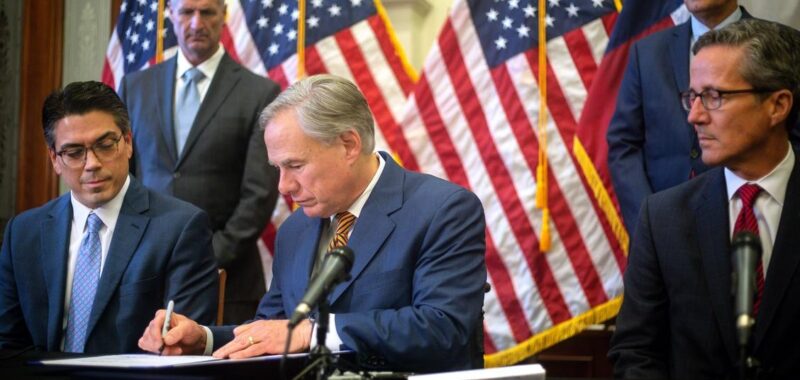AUSTIN, TX – JUNE 08: State Rep. Chris Paddie (L) and State Senator Kelly Hancock (R) watch as Texas … More
In Texas, electricity generating companies have no incentive to build enough power plants to keep the state online during periods of high demand – think hot August days or a winter freeze. For more than 25 years, the Texas Legislature has done nothing to address this fatal design flaw.
The Texas grid managed by the Electric Reliability Council of Texas, ERCOT, is an “electricity only” grid, meaning generators only earn revenue when they are actively feeding electricity to the grid. It also means ERCOT, the only purchaser of electricity in the wholesale market, only buys electricity on a minute-by-minute basis, without regard for the investment that is needed to power the state’s growing economy.
Before committing to build a natural gas power plant today, a company has to question what the ERCOT market will look like in the five years or more it will take to build the plant (which just got more expensive due to steel tariffs and a five-year backlog for gas turbines). Wind and solar farms require zero-cost fuel and few employees, so they will continue to displace more expensive coal and natural gas power plants in this minute-by-minute calculus. The obvious problem is that electricity from wind and solar farms is intermittent. Utility scale batteries will solve that problem in time, but not today.
Because the Texas government has consistently turned down commercial offers from investment groups to build new natural gas power plants, the state by default has gone all-in on the wind and solar farms that have exploded across the landscape.
So what’s the Legislature doing? Of the bills pending now, one would require wind and solar farms to contract for backup supply from dispatchable power plants or batteries. But there already are too few coal, natural gas, and nuclear power plants to satisfy peak demand in Texas, and there’s certainly not enough to backstop the growing supply of wind and solar. The bill’s requirement cannot be met in a timely manner. Is the Legislature’s preferred solution really to impede wind and solar growth when everyone in Austin knows only wind and solar power helped the state avoid rolling blackouts over the past two summers and winters. The cost of this requirement would be borne by the new wind and solar farms, rather than spread across all consumers – making less investment in all modes of generation more likely just when the state needs more electricity.
Another newly introduced bill that would provide hundreds of millions of tax dollars to nuclear power development is a tax-and-spend boondoggle. If started today, it would be years before new nuclear power could be added to the Texas grid. Texans need solutions now.
State officials still haven’t addressed the pending retirements of our existing power plants. Coal plants are, on average, more than 50 years old, while the natural gas fleet in ERCOT averages more than 30 years old. Texas has no authority to prevent the plant owners from retiring them. In fact, it makes financial sense for companies like NRG, Vistra, and NextEra to retire some of their power plants to squeeze the ERCOT market more frequently this year and next.
Think of the power plants as a cartel, one like OPEC, where withholding a little bit of supply can drive up the price. In ERCOT, withholding electricity during tight market conditions can drive the price to $5 per kilowatt hour, up from the usual price of 4 cents per kilowatt hour. ERCOT’s Independent Market Monitor reported that in 2023, the most recent year reviewed, Texans were overcharged by $12 billion. The IMM pronounced the market competitive because there was a “pivotal supplier” – one generator company that could affect the wholesale market price – only nine percent of the time. What the IMM ignored is the lesson of the movie “A Beautiful Mind”— tacit collusion among two or more suppliers blows away the “nine percent” theory. Data show that frequency and number of unplanned outages of generator units on the ERCOT grid is much higher than those experienced by the larger, federally regulated Pennsylvania, Jersey, Maryland (PJM) grid. This suggests the Texas generators are gaming the system by preemptively shutting down. Collectively, ERCOT’s electricity generators have Texans just where they want them.
Following California’s summer of 2020 grid failure, the state’s grid operator ordered 5,000 megawatts of new natural gas-fired generators to stabilize the state’s grid. California also employs a demand-response program, whereby the grid operator sends out text alerts asking consumers to voluntarily shut off their power during tight supply conditions. Texas could have done both for years but has not. A cynic might think it’s because doing so would cut profits for key political donors at the expense of Texans and the Texas economy.
The Legislature still has time to act. To do so will require the governor and legislators to ignore the million-dollar lobbyists representing their billion-dollar oligarchs and act for the benefit of all Texans.

